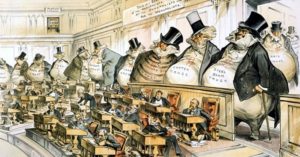In response to the concern regarding transport of crude oil through Washington State for foreign versus for domestic use:
Not all fossil fuels transferred through WA State are for domestic markets.
The refineries north of Seattle that receive crude by rail are not, unless there is some recent development of which I have not heard, equipped to transship crude rail to marine. Even if they export part of the finished product, the bulk of our local gasoline, diesel, heating oil, and jet fuel comes from those refineries.
Remember that oil is merely a commodity to those who buy, sell, and get rich from it. So often we say that the US should not be exporting “our” oil. In fact, none of it is “our” oil. It belongs to the companies that pay a fee to the government to extract it. The government has ceded control, as they have with other natural resources, in return for some cash.
I have maintained the position that trains and refineries are the wrong target for protest. We need to change habits. In Washington, we use 16,282 gallons of oil products per day (residential, commercial, industrial, and transportation), of which 13,020 gallons per day is used for transportation. Of that, 7,600 gallons per day is gasoline and the rest is diesel, LNG and LPG. That doesn’t count the oil products that we feel so good about recycling: plastic bottles, bags, and packaging.
One way or another, the crude to produce what we use (even if none of the product is exported) must get here, to our Washington State refineries. The alternatives are pipeline, rail, and truck.
Pipeline poses significant hazards per incident. There are about 280 significant (specific amounts of damage, injury, and volume) pipeline spills per year. These generally do not generate fire or injury, but a lot of environmental damage. There are fewer annual pipeline spills, but each is about three times larger than the average spillage from trains. Pipeline construction has a greater environmental impact than the use of existing or even expanded existing rail routes.
Rail also poses significant hazards per incident. There are more rail incidents than pipeline incidents, but in general, the effects of rail incidents in terms of environmental destruction, are about a third of the magnitude of pipeline incidents. In general, the safety of pipeline and rail are roughly equivalent per volume shipped. 99.99 percent of oil shipments by rail arrive at the destination without incident. The incidents involving spillage are .01 percent of the total shipments.
Truck is the other alternative for moving crude oil to Washington refineries. Get rid of the trains, build no pipelines, and truck is what is left. Each train carries roughly 600 truckloads of oil. Truck crash frequency (about 3,425,000 annually) is 1237 times train crash frequency (about 2,768 annually). That means an annual rate of 74,241 oil truck incidents per year per train. Nationally, there are about 4,500 crude oil trains per year. Were all to travel by truck, there would be approximately 334 million oil truck incidents per year, in addition to the current number of incidents for material shipped by truck. There is not much news nationally about petroleum truck crashes, spills, fires, and explosions. They are not as spectacular as oil train accidents, but they generate great damage (e.g., bridges burned beyond repair, related off-highway fires). This is much like the relatively minuscule incidence of airplane crashes. There are not many but each is spectacular, so they are widely and repeated (or continuously) covered by the media.
Every month, as many people are killed in highway crashes as there were in the attacks of 9/11/01 and every year, highway crash injuries are twice the US soldier casualty count in all wars since 1940. The news media never puts highway safety into that context. Unless there is some particularly spectacular incident, they slip quietly by except in the local news. A large part of 334 million truck accidents would probably slip quietly by too.
There is a lot of publicity given to the increasing number of oil train incidents particularly since about 2009. That would accompany the large increase in the shipment of crude oil by rail because the supply increased and the pipelines either don’t go where the crude is wanted or they are already at capacity.
The number has declined however, with the sharp reduction in domestic production as the market has shifted to economically favor Middle East oil. That reduction generates the additional and generally not considered consequence of being dependent on folks who really don’t like us, and giving them a lot of money to conduct their dislike. Then we deploy the military to protect our interests, which is effectively what we consider to be our oil under their dirt.
Increasing the amount shipped by pipeline would result in a greater number of pipeline incidents as well. The proposed Kinder Morgan pipeline across Canada is such an instance. The existing pipeline is at capacity and demand is growing. Even were there to be no export, the additional supply is needed here. The automobile population is growing at a rate similarly to the people population growth. The alternatives for supply are new pipeline, rail on existing lines, or truck.
Another issue that is of concern is the fact that there is not enough staff on these mile long oil trains to de-couple the cars at a mid-point to prevent a fire on one end sending the whole train into flames. Is this a Federal mgmt. issue or do BNSF (which handles 94%) and Union Pacific (6%) have capability to make us safer?
First let me correct the descriptor when referring to a long freight train: “Mile-long” has not accurately described a long freight train for a very long time. Typical freight trains are now generally 7,000 to 14,000 feet. Typical crude oil trains are 7,400 feet, or 1.4 miles long.
Regarding staffing: That would require some study to determine the effectiveness. Answers that I don’t have are: Among derailed trains, are there typically any cars that are not derailed that are not involved in spill, fire, or explosion? How close would be safe for the crew member to go to cut the rear end of the train from the derailment? How close would be safe for the front locomotive crew member to get to the derailment to cut the head end of the train away from the derailment?
The rail industry does not want oil train (or any other kind of train) accidents, or any other kind. They are expensive in many more ways than are visible. The employees certainly don’t want them. They must deal with them in person. The Federal Railroad Administration doesn’t want railroad accidents of any kind. The regulations on rail safety are thorough (49 CFR 200-299). As well, Pipeline and Hazardous Materials Safety Administration (49 CFR 105-110, 130, and 171-180) and Enhanced Tank Car Standards and Operational Controls for High-Hazard Flammable Trains (80 FR 26643) apply. Also, the FRA established the Railroad Safety Advisory Committee (RSAC) to develop new regulatory standards, through a collaborative process, with all segments of the rail community working together to fashion mutually satisfactory solutions on safety regulatory issues. Members of RSAC include the industry, consultants, and labor. Yes, it says mutually acceptable. That is not a case of industry telling regulators what to do, it is a matter of figuring out what works and what is a waste of time and money.
The industry also operates Transportation Technology Center (TTC) in Colorado, where track and train technology is developed. Trains (often instrumented) operate continuously on a loop (generally instrumented) track in order to test new technology for safety and durability and to better predict and preempt failure.
According to March 2017 Federal Railroad Administration data based on per million train miles, since 2000:
- Train accident rate is down 44%
- Equipment-caused accident rate is down 34%
- Track-caused accident rate is down 53%
- Derailment rate is down 44%
These downtrends in accident rates can be generally attributed to the results of TTC’s research.
Should anyone have a realistic idea for safety improvement (such as the crew on the rear end of the train), contacting the Federal Railroad Administration is in order. If they have not already considered it, they will indeed consider the matter.
In the end, it still comes down to that we aren’t going to stop taking it out of the ground and transporting it until we stop using it. Maybe it doesn’t seem fair to single out the users as the problem, but were it not for them, there would be no production.
-30-
Thos


